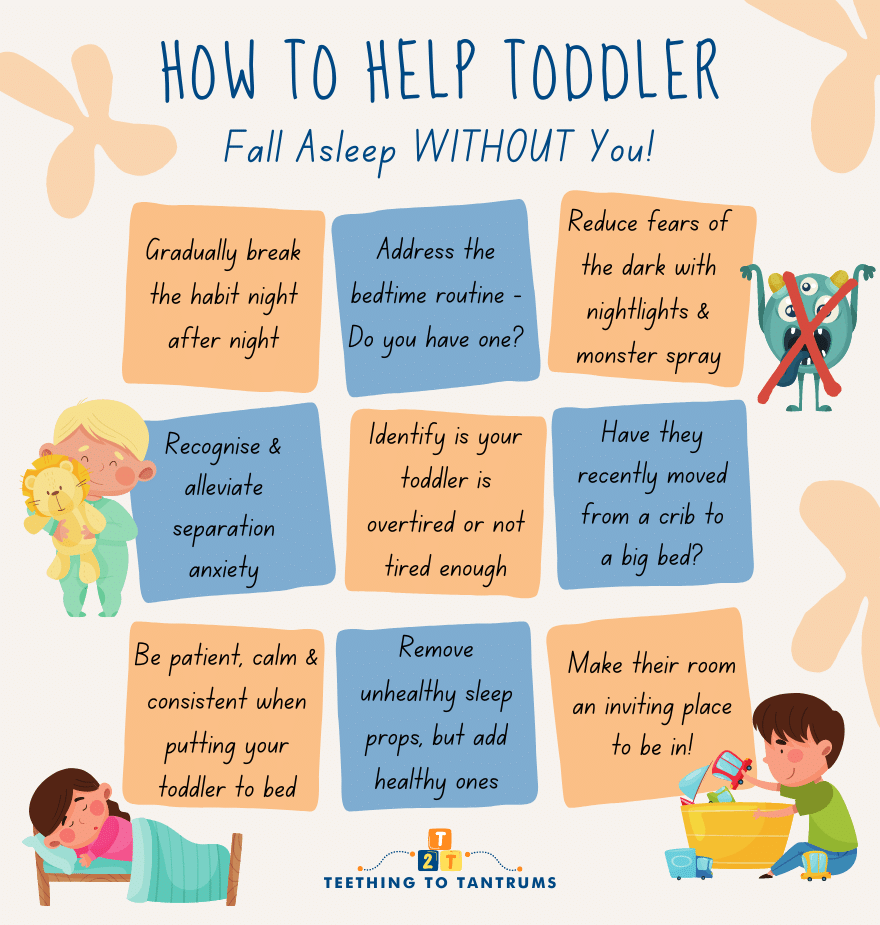Is your toddler refusing to go to sleep? The reasons can be many, including changes in routine, development milestones, fears, or simply not being tired. This article will explore these reasons and give you proven strategies to help your toddler sleep better. Bedtime battles are common, but with the right approach, you can reclaim your evenings and help your child get the rest they need.

Image Source: www.teethingtotantrums.com
Fathoming Toddler Sleep Resistance
Toddler sleep resistance is a widespread problem. Many parents struggle with bedtime battles toddler and toddler sleep refusal. It’s not just about being difficult; often, underlying reasons contribute to this behavior. These can include developmental leaps, changes in routine, or even a simple desire for more attention. It’s crucial to try to understand the why behind your toddler’s resistance to find effective solutions.
Common Culprits Behind Toddler Sleep Problems
Several things can lead to your toddler’s nighttime struggles. Identifying these factors is the first step in addressing the problem.
- Developmental Milestones: Learning new skills, like walking or talking, can disrupt sleep patterns.
- Separation Anxiety: Toddler separation anxiety sleep is a real issue, especially around bedtime.
- Changes in Routine: Travel, new siblings, or daycare transitions can throw off a toddler’s sleep schedule.
- Fear of the Dark: This is a common fear that can make bedtime scary.
- Too Much Screen Time: Toddler overstimulated at bedtime due to screens can have trouble winding down.
- Inconsistent Bedtime Routine: A lack of a predictable bedtime routine can lead to confusion and resistance.
- Medical Issues: Sometimes, sleep problems can be related to ear infections, allergies, or other health concerns.
- Teething: The pain and discomfort of teething can definitely interfere with sleep.
Distinguishing Between Sleep Regression and Normal Resistance
Sometimes, a sudden change in sleep habits might indicate a toddler sleep regression. These regressions often happen around specific ages (like 18 months or 2 years) and are linked to brain development. However, not all sleep disturbances are regressions. Normal resistance can stem from various situational factors. The following table explains the differences.
| Feature | Sleep Regression | Normal Resistance |
|---|---|---|
| Timing | Occurs around predictable developmental periods | Can happen anytime due to external factors |
| Duration | Typically lasts 2-6 weeks | Can be shorter or longer depending on the cause |
| Cause | Brain development, new skills being learned | Changes in routine, separation anxiety, etc. |
| Other Symptoms | Increased fussiness, clinginess | May be related to specific events or times |
Deciphering the Reasons Behind Bedtime Battles Toddler
Why do toddlers suddenly fight sleep? Let’s break down the common reasons leading to those nightly power struggles.
Exploring Psychological Factors
A toddler’s emotional state heavily influences their sleep. Consider these psychological factors:
- Anxiety: Toddler nighttime anxiety can manifest as fear of the dark, monsters, or being alone.
- Need for Control: Bedtime can feel like a loss of control for a toddler. They might resist to assert their independence.
- Desire for Attention: Bedtime can be a way to get extra attention from parents.
- Dreaming and Nightmares: As toddlers’ imaginations grow, so does the possibility of unsettling dreams.
Assessing Environmental Influences
The environment in which a toddler tries to sleep plays a huge role.
- Room Temperature: Is the room too hot or too cold?
- Noise Levels: Is there too much noise from inside or outside the house?
- Light Exposure: Is the room dark enough? Even small amounts of light can disrupt sleep.
- Comfort of Bedding: Is the mattress comfortable? Are the sheets and blankets soft and cozy?
Analyzing Routine and Schedule Issues
Inconsistent or poorly structured routines are a significant contributor to sleep problems.
- Inconsistent Bedtime: A varying bedtime makes it hard for a toddler’s body to regulate its sleep-wake cycle.
- Overtiredness: An overtired toddler often has more trouble falling asleep.
- Napping Issues: Erratic nap schedules or naps that are too long or too late in the day can disrupt nighttime sleep.
- Meal Timing: Eating too close to bedtime can cause discomfort and keep a toddler awake.
Addressing Common Toddler Sleep Challenges
What can you do to solve toddler sleep refusal? Here are some practical strategies.
Crafting a Consistent Bedtime Routine
A predictable bedtime routine is the cornerstone of good sleep habits. Follow these steps to build an effective one:
- Start Early: Begin the routine about an hour before bedtime.
- Calming Activities: Include calming activities like a warm bath, reading stories, or quiet playtime.
- Avoid Screen Time: Limit screen time for at least an hour before bed.
- Consistent Order: Follow the same steps in the same order every night.
- Keep it Short: Aim for a routine that lasts no more than 30-45 minutes.
Implementing Effective Sleep Training Tips
If routine adjustments aren’t enough, consider sleep training techniques.
- The Ferber Method: This involves checking on your child at increasing intervals after putting them to bed.
- Chair Method: Sit in a chair next to your child’s bed until they fall asleep, gradually moving the chair further away each night.
- Pick-Up/Put-Down Method: Pick up and comfort your child when they cry, then put them back down in the crib or bed when they calm down.
- Gentle Methods: Some parents prefer gentler approaches, such as staying in the room until the child falls asleep, then gradually reducing their presence over time.
Important: It is critical to note that any sleep training method should be undertaken with thoughtful consideration of your child’s temperament and your family’s values. If you are concerned, speak with your pediatrician.
Strategies for Managing Separation Anxiety Sleep
Separation anxiety is a common cause of bedtime battles. Here’s how to help your toddler feel more secure:
- Transitional Objects: Allow your child to sleep with a favorite stuffed animal or blanket.
- Reassurance: Offer plenty of reassurance and affection during the day.
- Gradual Separation: Practice short separations during the day to help your child get used to being apart from you.
- Stay Calm: When saying goodnight, be calm and confident. Avoid lingering or showing anxiety yourself.
- Nightlights: A dim nightlight can help ease fears of the dark.
Handling Toddler Won’t Stay in Bed Situations
When your toddler keeps getting out of bed, it can be frustrating. Here’s how to handle it:
- Consistent Response: Calmly and quietly return your child to bed each time they get up.
- Avoid Engaging: Don’t get into a conversation or give in to requests for water, snacks, or extra stories.
- Check for Comfort: Make sure your child is comfortable – not too hot or cold, and that they’ve used the bathroom.
- Consider a Toddler Bed Rail: This can help prevent your child from accidentally falling out of bed and reduce the urge to get up.
Dietary and Lifestyle Adjustments
What your toddler eats and does during the day can impact their sleep at night.
- Limit Sugar and Caffeine: Avoid sugary drinks and snacks, especially in the afternoon and evening.
- Healthy Diet: Ensure your child eats a balanced diet throughout the day.
- Regular Exercise: Physical activity can help tire out a toddler, but avoid strenuous exercise close to bedtime.
- Sunlight Exposure: Expose your child to natural sunlight during the day to help regulate their circadian rhythm.
Preventing Future Bedtime Problems
Proactive measures can help prevent future sleep disturbances.
Maintaining Consistency
Consistency is key to preventing future bedtime battles toddler. Stick to the established routine, even on weekends and during vacations.
Recognizing Early Signs of Trouble
Be aware of the early signs of sleep problems, such as increased fussiness, difficulty settling down, or changes in nap patterns. Addressing these issues early can prevent them from escalating.
Adapting to Developmental Changes
As your child grows and develops, their sleep needs may change. Be flexible and adjust the routine as needed.
Creating a Sleep-Conducive Environment
Ensure your child’s bedroom remains a haven for sleep. Keep it dark, quiet, and cool.
When to Seek Professional Help
While many sleep problems can be resolved with consistent routines and simple strategies, sometimes professional help is needed.
Identifying Red Flags
Watch out for these red flags:
- Snoring or Gasping: This could indicate sleep apnea.
- Frequent Night Terrors: These can be very distressing for both the child and the parents.
- Excessive Daytime Sleepiness: If your child is constantly tired during the day, it could be a sign of a sleep disorder.
- Persistent Sleep Problems: If sleep problems persist despite your best efforts, seek professional help.
Consulting with a Pediatrician or Sleep Specialist
If you are concerned about your child’s sleep, talk to your pediatrician. They can rule out any underlying medical conditions and recommend a sleep specialist if needed.
Frequently Asked Questions (FAQ)
- What is the best age to start sleep training? Most experts recommend starting sleep training around 4-6 months of age. However, you can adapt techniques for older toddlers as well.
- Can I let my toddler cry it out? The “cry it out” method is a personal choice. Some parents find it effective, while others prefer gentler approaches. Consider what works best for your family and your child’s temperament.
- How long should a bedtime routine be? A bedtime routine should typically last 30-45 minutes.
- My toddler is suddenly waking up in the middle of the night. What should I do? Check for common causes like teething, hunger, or temperature. If the problem persists, consider whether it might be related to separation anxiety or a sleep regression. Re-evaluate the bedtime routine for gaps.
- Is co-sleeping a good idea? Co-sleeping is a personal decision with potential benefits and risks. If you choose to co-sleep, make sure to follow safe co-sleeping guidelines. The AAP does not recommend bed-sharing with infants.
- What are some signs of toddler overstimulated at bedtime? Signs include difficulty winding down, hyperactivity, restlessness, and trouble falling asleep.
- My toddler won’t stay in bed. What should I do? Consistently and calmly return your child to bed without engaging in conversation. Make sure their needs are met (e.g., bathroom, comfort).
- How do I cope with toddler sleep regression? Be patient, consistent with your routines, and offer extra comfort and reassurance. Understand that it is a temporary phase.
- Are there any safe natural sleep aids for toddlers? Discuss natural remedies with your pediatrician before trying them. Options might include chamomile tea (consult your doctor first), a warm bath, or aromatherapy (lavender).

Clark Lubowitz is a parenting expert with over 10 years of experience in toddler care and child development. Holding a degree in Early Childhood Education, he specializes in blending modern technology with parenting, offering expert advice on the best toddler gadgets. Through his work on ToddlerAwesome.com, Clark provides valuable insights to help parents make informed decisions for their little ones.
